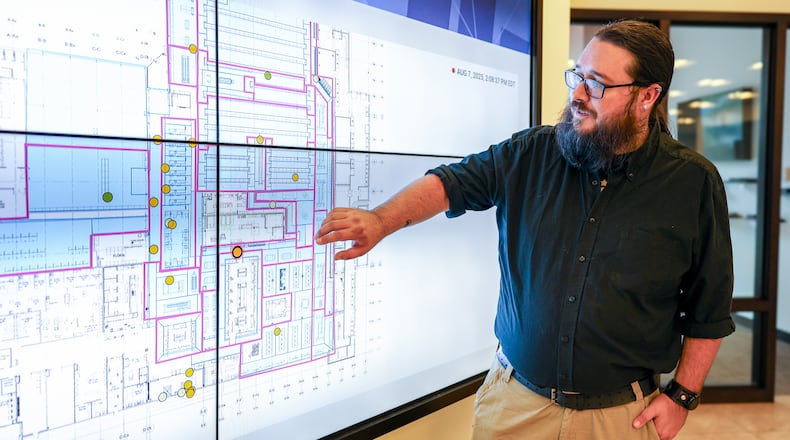Ristich works with the University of Dayton Research Institute as executive director of that institute’s digital and systems engineering sector.
But not long ago, he worked for the Air Force Research Laboratory leading the Integrated Capabilities Directorate at Wright-Patterson Air Force Base.
Ristich was with AFRL while the Air Force refined the X-62A experimental airplane, which saw a number of what the Air Force hailed last year as breakthroughs in autonomous air-to-air combat.
Ristich’s office made key investments in modifications to the X-62A.
“Oh, I’m more than a believer,” Ristich said in a recent interview.
At UDRI, AI is an increasingly common tool to help clients solve problems and make decisions. Nearby at Wright-Patterson (and elsewhere), AFRL and the Air Force have harnessed AI to perhaps change how air war will be fought one day.
Ristich worked for the Air Force for 36 years. He has been with UDRI for about eight months, as of early August.
“We invested in actual modifications to the X-62 to allow it to operate under autonomous conditions, basically, with a pilot inside the cockpit,” he recalled. “And we added other features that allowed it to emulate some of the designs for the unmanned systems that we were exploring for operational use.”
Former Air Force Secretary Frank Kendall flew on the X-62A VISTA at Edwards Air Force Base in May 2024.
Kendall walked away from the experience saying “the potential for autonomous air-to-air combat has been imaginable for decades, but the reality has remained a distant dream up until recently.”
“This is a transformational moment,” Kendall said.
‘The real power of AI’
With AI, advocates say transformational moments are becoming more common.
Ristich ticked off several real-world examples: UDRI has worked with an automotive manufacturer who was having problems with castings for engine blocks.
UDRI helped that manufacturer by using infrared cameras to inspect where engine blocks were failing. Using AI-powered cameras, UD researchers were able to help predict whether a block will be successful.
“By doing that, we were able to help the manufacturer save ... $400,000 for each of the 13 production lines that they have,” Ristich said.
He declined to identify the manufacturer, but said it was not Brookville and Moraine engine producer DMAX.
Cameras powered by AI can pinpoint patterns, capturing problems quickly and at scale — “something that the human eye could never do,” Ristich said.
On the medical side, UDRI has used sensors to inspect X-rays and CT scans, to detect lung nodules or masses — a possible sign of cancer.
Credit: Bryant Billing
Credit: Bryant Billing
In many cases, early detection makes the difference between life and death.
AI-powered sensors are a technology with 98% accuracy, Ristich said. Such sensors can help spot wildfires or assist in human-machine teaming, to help arrive at decisions. AI can take large amounts of disparate information — images, intelligence, numbers, more — and distill that into recommended courses of action.
“To me, that’s the real power of AI,” Ristich said. “How do you team it?”
Knowing what you know — and what you want
For Stratacache, AI figures heavily in its “Walkbase” analytics technology — a way to track where customers go in stores, where they linger and what interests them.
“When we pair AI with shopper analytics, I can help lead you to what you’re looking for even before you know what you want,” said Chris Riegel, Stratacache founder and CEO.
Walkbase technology tracks a consumer’s behavior in a grocery store, for example, over a range of trips. Radio signals and bluetooth technology tied to a shopping cart, for example, can be tracked to see where customers go.
Credit: Bryant Billing
Credit: Bryant Billing
“You can build a behavioral profile of a customer, that says, ‘Hey, transactionally, I’m not a foodie. I don’t drink alcohol. I like to buy from the butcher’s counter.’ What are those things you can learn about the customer that are relevant,” Riegel said.
Retailers like to know exactly what customers buy and what interests them, Riegel noted.
“I know what you looked at, because I know where you spent your time, how fast you walked through an area, what did you stop and consider as you went through a store,” he said.
That history helps retailers understand, for example, that you own pets or have an affinity for French red wine.
This information can be “re-trafficked” to streaming services. “Next thing you know, you’re watching Netflix, and on Netflix, you’re seeing these promotions of French wines,” Riegel said. “Why is that?”
‘World-changing industries’
Stratacache purchased Walkbase, a digital media/ad tech solution company, out of Finland in 2017. That purchase helped make Stratcache unique in the world of behavioral data, Riegel said.
“It’s impacting dozens and dozens of parts of our business,” he said.
There is fear around AI, Riegel acknowledges. But he believes it will unlock economic opportunity.
“It’s a monstrously large opportunity,” he said. “For anybody who’s out there trying to understand it, it’s worth researching and learning more about because there will be world-changing industries coming from it.”
Will McKelvey’s New York City early stage venture capital investing firm, Lerer Hippeau, recently led a $5.8 million seed round boosting the AI-focused startup of Mitchell Jones — like McKelvey, a Dayton native and Chaminade-Julienne graduate.
“The pace of AI is changing so rapidly that the best-positioned organizations are those that adopt now and learn and grow alongside the technology,” McKelvey said. “Is it perfect now? No, but simply using it will put organizations ahead of many of their competitors, and that gap will widen as the technology improves.”
Harnessing the power of language
“We here at Luxid utilize AI to enhance talent — not replace it,“ said Jonah Otchy, U.S. group creative director for Luxid. ”We’re using AI tools in ways that help us work more efficiently and serve our clients with sharper precision."
Proposal writing comes down to crafting clear language, Otchy said. His business uses generative AI to draft statement-of-work copy meant to be concise and clear.
Credit: Bryant Billing
Credit: Bryant Billing
And large language models help the firm articulate speaker notes and talking points — ensuring teams are on the same page.
“AI has also become indispensable in tasks like keyword clustering for massive paid search accounts, identifying potential influencers, and solving complex Excel or macro problems in minutes — freeing us up to do more strategic thinking," Otchy said.
Luxid also uses AI tools to generate voiceovers, produce storyboard visuals, and even animate images for client videos.
While a recent research report from McKinsey & Co. found more companies, like Luxid, are spending more on generative AI — a form of AI that creates content, such as images, video and even audio — many are reporting little impact on their bottom lines, at least not yet.
“Think of it as the ‘gen AI paradox,’” the report said.
Saving time — and lives
Dayton hospital network Premier uses AI to support patients, staff and company goals, said Dr. Walter Reiling, chief medical informatics officer for Premier.
“And of course, everyone is looking to be more efficient,” Reiling said.
He said his team tends to look at the question or problem to be solved first before deciding if AI is the right answer. Just because an AI program comes along, that doesn’t mean it’s useful, he said.
“The shiny object scenario,” Reiling called it. “Where I see something cool, and I think this is neat. And oftentimes, it is very cool. But if it’s not really solving a problem we need to solve, then it’s not something we want to jump into.”
Premier physicians use AI for an array of purposes, from helping to document doctor-patient encounters by generating detailed notes in draft form, to perusing reams of data that would be difficult for humans to process, and doing all of it 24-7.
And it can be helpful to care providers.
For about two years, AI architecture has helped monitor patient conditions. There are algorithms that monitor lab work, vital signs and a host of other telltale signals to alert a care team to a patient who might be moving in the wrong direction.
Reiling said it’s difficult to say that AI has definitely saved a life at this point. But having the right information at the right time can do just that, he said.
“Early intervention absolutely saves lives,” he said.
Premier has been using AI in monitoring patients for a couple of years, and Reiling expects to continue to use it. “It’s very good and very helpful in its current state.”
AI tools are continually updated, he also noted. “If we talk again in a year, we’ll probably have 20 more things to add to the list,” he said.
About the Author





